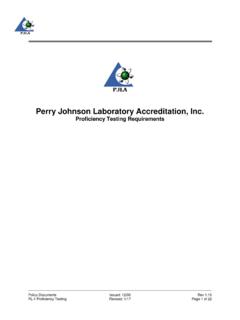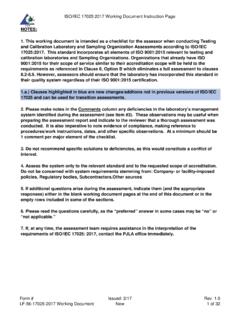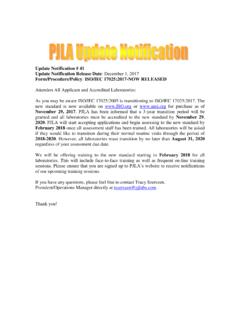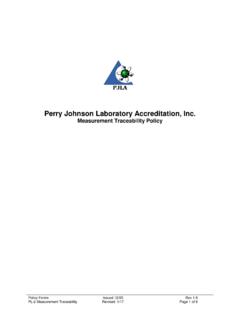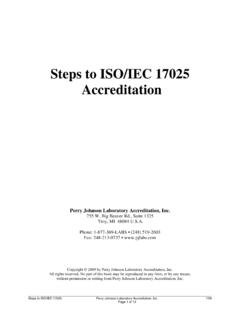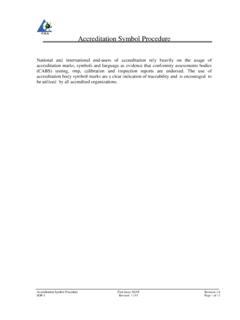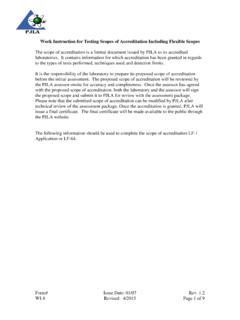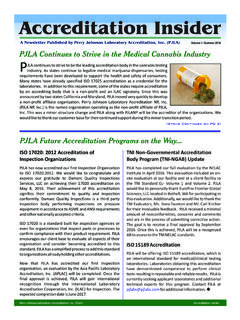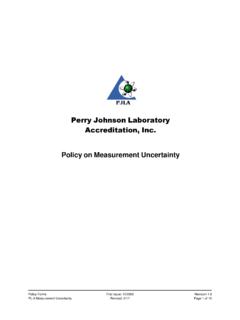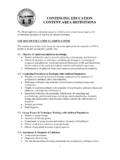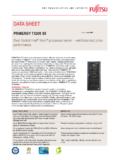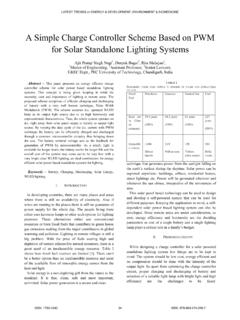Transcription of Understanding and Expressing Measurement …
1 Understanding and Expressing Measurement Uncertainty associated with DC and Low Frequency Metrology Edward Brown Quality Systems Lab Boca Raton, FL 33487 Introduction Periodic calibration of electronic systems isrequired due to the large number and widevariety of components in basic measurementand sourcing systems. In metrology today acalibration laboratory needs to understand howto quantify all the influences and componentsof Measurement uncertainty as they pertain tothe laboratory s environment.
2 Theseuncertainty influences and components are asvaried as the cables used in a measurementsystem to the training level of the technicianstasked with operating this system. Consistentresults and confidence in the reported values ofa Measurement can be achieved with dueconsideration to all the contributors ofuncertainty. This paper is intended to help thelaboratory professional begin evaluation of thepossible sources of uncertainty and how toformulate a Measurement uncertainty budget.
3 Common terms: Accuracy is a qualitative expression of thecloseness of a Measurement s results to the truevalue. Precision is a measure of repeatability. A highprecision indicates the ability to repeatmeasurements within narrow limits. Resolution is the smallest change that can bedetected. Generally today with moderninstruments this is the smallest increment thatcan be displayed or LSD. Uncertainty is a quantitative term thatrepresents a range of values wherein the truevalue may lie.
4 Uncertainty and confidence isdetermined using statistical techniques. Traceabilityis the ability to relate individualmeasurement results to national standards ornationally accepted Measurement systemsthrough an unbroken chain of comparisons. Requirements for sound analysis: Stable Environment; before a laboratory canbegin to evaluate the components ofuncertainty in a Measurement or calibrationsystem, data must be collected to determine ifthe system is stable. This data may be assimple as monitoring the ambient environmentusing a temperature and RH logger or ascomplex as repetitive Measurement schemes ofthe equipment under evaluation.
5 Proper Training of Personnel; all personneltasked with performing measurements toassimilation of collected data should beproperly trained and evaluated on theirunderstanding of the tasks assigned to them. Traceable Standards; all standards used in anuncertainty-testing scheme must be traceablefor the results to be meaningful. Uncertainty considerations; all possiblesources of uncertainty should be consideredfrom AC line voltage fluctuations to theresolution of the Measurement system.
6 Asource of uncertainty such as cable EMF maybe discarded after determining that theuncertainty is insignificant. It may beappropriate in some test schemes to combineall of the insignificant uncertainties and createa label for this combined specifications are the most commonsource of uncertainty data, however properconsideration must be given to the Page 1 of 4 Systematicerrors relate to the equipment used inthe Measurement process or external influenceson the equipment.
7 Examples include: loadingeffects, thermals, drift-rate, leakage currents, andexternal noise. Gross errors are caused by the technician andcan be strictly controlled with proper include: misreading of instrumentresults, incorrect adjustments, using the wronginstrument, errors in recording calibration data,and computational errors. All of these errors canbe avoided with proper training and attention todetail. Classifications of uncertainty Type A evaluation method;the method ofevaluation of uncertainty of Measurement by thestatistical analysis of a series of example would the standard deviation of aseries of measurements taken by a laboratorytechnician.
8 Type B evaluation method; the method of evaluation of uncertainty of Measurement by means other than the statistical analysis of a series of observations. An example would be the manufacturer s published specifications for an instrument. Methods of determining uncertainty Published specifications; as mentioned earlierpublished specifications are the most commonsource of uncertainty data used by commercialcalibration laboratories. This method is the mostappropriate for laboratories that take only simple measurements.
9 Simple measurementscan be defined as any Measurement that is withinthe common functional capabilities of aninstrument. This method of determinationisconsidered a Type B uncertainty. Statistical methods; this method requires thetaking of a series of measurements over aspecified length of time. This method is themost robust and is appropriate for any laboratorythat requires high confidence intheirmeasurement uncertainty statements. This is aType A uncertainty. manufacturer s stated confidence level.
10 If themanufacturer did not specify a confidencelevel, then a rectangular distribution should beassumed, more on distributions later. Sources of Uncertainty Uncertainty in the results of a measurementcan be affected by many factors, someconsiderations: Reference standards and measurementequipment: Uncertainty in their calibration;long term drift; resolution; vibration; electromagnetic interference; sensitivity to changeduring transportation and handling. Measurement Setup: cables; shielding; warmup time; thermal voltage influences; Measurement probes.
